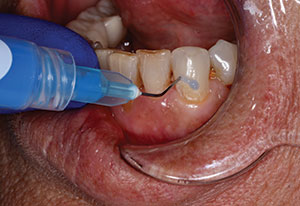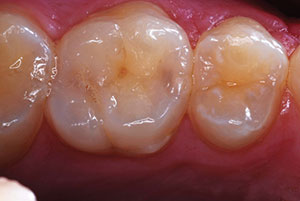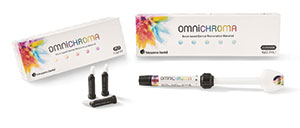 |
| Figure 1. Full-face preoperative (2004) view of patient. |
INTRODUCTION
Material selection poses one of the most demanding dilemmas facing clinicians. With so many restorative dental products available today, which one is the most appropriate for our patients’ needs? Is stacked, pressed, or substrate-supported porcelain indicated; or should a metal, a direct, or an indirect composite be used? If an all-ceramic is to be considered, there are a multitude of porcelain systems from which to choose, all having subtle and, sometimes, dramatic differences. Knowing the specifications and nuances of each porcelain system, as well as the clinical demands of the patient, would greatly assist the clinician in making the appropriate choice.
CASE REPORT
Diagnosis and Treatment Planning
This patient presented for treatment in 1972 with a list of needs. Multiple missing teeth, along with discoloration of his remaining dentition, posed a difficult challenge.
His treatment plan consisted of 5 bridges (Nos. 2 to 4, 5 to 7, 12 to 14, 18 to 21, and 28 to 31), 6 veneers (Nos. 22 to 27), and 4 PFMs (Nos. 8 to 11). The material that was used at the time, DENTSPLY Ceramco, was probably the most popular PFM system in the early 1970s and was fairly easy to master by dental technicians. Within several months, treatment had been completed and all were pleased with the results. The patient relocated and did not return for 27 years.
In 1999, the patient returned and his lower anterior teeth were in need of repair. During his time away from our practice, his 6 mandibular anterior teeth had been repaired with a pressed leucite-reinforced porcelain system (Authentic [Ceramay]). At this time, this all-ceramic material was stronger than most other pressable systems and had superior optical properties. In addition, these restorations could be done using a conservative preparation design. These veneers were originally prepped to 0.8 mm axial reduction and 1.5 mm incisal edge reduction, which had proved adequate to conceal the discolored preparations using the Authentic porcelain. All of the previous restorations, including these 6 veneers, were built to match the original shade (A3.5) of his natural teeth (VITA Classical Shade Guide [VITA North America]).
 |
 |
| Figure 2a. Right lateral perspective retracted view showing old and patched margins. | Figure 2b. Left lateral retracted view showing repaired margins. |
 |
| Figure 2c. Preoperative retracted view demonstrating 32-year-old PFM crowns. |
 |
 |
| Figure 3a. Occlusal view of maxillary arch demonstrating minimal wear after 32 years. |
Figure 3b. Occlusal view of mandibular arch demonstrating minimal wear after 32 years. |
In 2004, all of his Ceramco and Authentic restorations were still intact. However, several facial margins had been patched and several small areas of occlusal wear with exposure of the metal substructure were observable. The original Ceramco restorations were now 32 years old and holding up quite well (Figures 1 to 3). One contributing factor to the longevity of these restorations had been the utilization of the principles of occlusion, as taught by Dr. Peter Dawson, in the restorative treatment protocol. According to Dawson, to be considered healthy and maintainable, the teeth must present without excessive wear, hypermobility, or migration out of an acceptable alignment.1 In addition, great care had been given to rebuild his teeth in centric relation position with adequate anterior guidance, no posterior interferences, and adequate crossover. Ideal margin design, axial taper, and occlusal clearance of the prepared teeth allowed for this balance of occlusal forces that had preserved and protected the porcelain throughout the years. This patient had developed a thriving commercial real estate business and wanted to enhance his smile with brighter teeth and a more youthful smile. Having studied the work of Dale Carnegie, he was aware that a smile can indeed “win friends and influence people.”2 The decision was made to replace all of the old Ceramco and Authentic A3.5 restorations with more of a true bleach shade. Although material selection can be a challenge, matching the aesthetic demands of the patient with the properties of materials can produce excellent clinical results.3
Clinical Protocol
Several factors influence material selection. With the number of missing teeth and need for strength, a PFM system was selected for the maxillary arch and the mandibular premolars and molars. Very little additional preparation was required since the teeth had been previously prepared for PFMs. The Noritake EX-3 (Kuraray Noritake Dental) would provide a good match. This all-ceramic demonstrates outstanding resistance to fracture and superior handling properties for the dental technician. It is very stable with multiple firings due to its stable coefficient of thermal expansion, and it possesses natural florescence and utilizes a final layer of “Luster Porcelain.”4 This low-wearing layering porcelain is a smaller particle-size porcelain that is less abrasive to the opposing teeth.
 |
 |
| Figure 4. The start of veneer preparation in the mandibular anterior teeth. | Figure 5. Postoperative frontal view of prepped mandibular veneers. Here a rigid red pattern resin (GC America) was used to record the bite registration. |
 |
 |
| Figure 6a. Right lateral view: completed mandibular restorations on mounted models. | Figure 6b. Left lateral view: completed mandibular restorations on mounted models. |
 |
| Figure 6c. Frontal view: completed mandibular restorations on mounted models. |
Success of PFM restorations depends fundamentally on the union ability between the 2 materials that should not undergo fatigue or fracturing under different conditions.5 It has been reported that shear bond strength means greater than 10 MPa indicates clinically satisfactory results, representing a higher bond strength value than that required to cause the clinical flaw of metal-ceramic union.6-10 A comparative shear test study found that shear bond strength means (+/- SD) for Noritake to be 28.96 MPa +/- 6.92 MPa.5 The patient’s maxillary arch and mandibular posterior teeth were to be made with the Noritake EX-3 system (shade No 0.5). His mandibular anterior teeth were to be made with the Authentic system bleach shade 020 (Bleach Shade Guide [Ivoclar Vivadent]). These 6 anterior mandibular teeth had recently been restored with conservative veneer preps 5 years prior. It was determined that there was no reason to prep any more lingual tooth structure and change to full coverage. The Authentic pressable system was selected due to its excellent strength and optical properties, and because it could be used with minimally invasive preparation designs. Authentic offers 58 different fluorescent pressable ingots in a range of opacities that mimic the vitality of the natural dentition in all lighting sources.11
 |
 |
| Figure 7a. Right lateral view showing new mandibular bleach shade restorations. | Figure 7b. Left lateral view. Note the lower value and richer chroma of the 32-year-old maxillary restorations. |
 |
| Figure 7c. Frontal view demonstrating the contrast between the 32-year-old maxillary restorations and the new bleach shade of the mandibular restorations. |
Our treatment plan was quite simple. Prep and replace the mandibular restorations, then do the same for the maxillary restorations. The mandibular veneer preps involved a 0.8-mm axial reduction with a 1.0-mm incisal reduction utilizing a rounded chamfer margin for the mesial, distal, and facial aspects. The veneer preps extended through the contacts, creating a 90° finish line on the lingual aspect of each tooth. Figure 4 demonstrates the beginning of the preparation of the mandibular arch. After preparation of the mandibular 6 anterior teeth, a rigid red pattern resin (GC America) was used to capture the anterior aspect of vertical dimension in centric relation position with upper and lower posterior teeth in a closed bite (Figure 5). Teeth Nos. 2, 14, 18, and 31 were then prepped to 1.5 mm axial reduction and 2.0 mm occlusal reduction with a 360° light chamfer margin for PFM restorations.
 |
 |
| Figure 8a. Right retracted view of the wax bite used to mount the new mandibular restorations against the unprepared maxillary arch. | Figure 8b. Left retracted view of the bite transfer. |
 |
 |
| Figure 9a. Frontal retracted view of maxillary preps after the mandibular veneers had been inserted. This anterior bite record was made before the posterior teeth were prepped. | Figure 9b. Frontal view showing 2 additional posterior bite records. In total, 3 bite records, made out of a rigid pattern resin (GC America), were used to capture the vertical dimension of occlusion and the centric relation position. |
The remaining teeth that would have PFM restorations (Nos. 4, 5, 7, 8 to 11, 21, and 28) were prepped with a porcelain butt margin on the facial aspect and a light chamfer (for a gold collar) interproximally and on the lingual. The anterior bite was repositioned and a similar resin bite was fabricated for each posterior side. In other words, 3 bite registrations were in place, capturing the exact centric relation position at an accurate vertical dimension. The casts were mounted on the Sam III articulator (Great Lakes Orthodontics) and the mandibular restorations were fabricated (Figure 6).
In Figure 7, one can see the mandibular arch in place, demonstrating the new bleach shade. The following morning was reserved to prep the maxillary arch and place temporaries that would better match the new bleach shade mandibular restorations. A wax-bite technique (DeLar Bite Registration Wax [DeLar] and Great Lakes Master Wax [Great Lakes Orthodontics]) was used to transfer the mandibular cast to the unprepared maxillary arch (Figure 8). The first rigid red pattern resin by GC America was made, the posterior teeth were prepared, and the last 2 resin bites fabricated (Figure 9).
In Figure 10, all of the maxillary restorations had been finalized, and three 3-unit bridges along with 4 single crowns fabricated. The final restorations captured the improved appearance of a new bleach shade (Figures 11 and 12).
 |
 |
| Figure 10. This maxillary occlusal view shows the three 3-unit PFM bridges, along with 4 single crowns. | Figure 11. Full-facial view showing the completed restorations. |
 |
| Figure 12. Facial view showing the new PFM (Noritake EX-3 [Kuraray Noritake Dental]) restorations along with 6 mandibular (Authentic [Ceramay]) restorations. |
CLOSING COMMENTS
During the course of 32 years, restorative materials have evolved to meet both the functional and aesthetic demands of the clinician and patient. Selection may pose a dilemma in some cases, and a thorough evaluation of the patient’s masticatory system is key to matching the restorative material best suited to achieve the restorative goals. Although his former restorations were functioning and healthy after 32 years, the patient now has a much-improved smile that should last him for years.
Acknowledgment
The authors would like to thank Mr. John Wilson (Wilson Dental Arts; Raleigh, NC) for the excellent technical work done for this case.
References
- Dawson PE. Functional Occlusion: From TMJ to Smile Design. 3rd ed. St. Louis, MO: Mosby; 2007.
- Carnegie D. How to Win Friends and Influence People. Revised edition. New York, NY: Pocket Books; 2010.
- Wynne W, Leinfelder K. Material selection: a case report. Dent Today. 2005;24:90-93.
- Kuraray Noritake Dental Inc. Dental porcelain for metal framework restorations. kuraraynoritake.com/products/dental-porcelain-and-laboratory-related-materials/ex-3. Accessed October 20, 2015.
- Scolaro JM, Pereira JR, do Valle AL, et al. Comparative study of ceramic-to-metal bonding. Braz Dent J. 2007;18:240-243.
- Anusavice KJ. Noble metal alloys for metal-ceramic restorations. Dent Clin North Am. 1985;29:789-803.
- Chong MP, Beech DR. A simple shear test to evaluate the bond strength of ceramic fused to metal. Aust Dent J. 1980;25:357-361.
- Hammad IA, Talic YF. Designs of bond strength tests for metal-ceramic complexes: review of the literature. J Prosthet Dent. 1996;75:602-608.
- Papazoglou E, Brantley WA, Johnston WM, et al. Effects of dental laboratory processing variables and in vitro testing medium on the porcelain adherence of high-palladium casting alloys. J Prosthet Dent. 1998;79:514-519.
- Böning K, Walter M. Palladium alloys in prosthodontics: selected aspects. Int Dent J. 1990;40:289-297.
- Jensen Dental Inc. Authentic Pressable All-Ceramic Porcelain. jensendental.com/authentic/index.htm. Accessed October 20, 2015.
Dr. William Wynne has a private practice in Raleigh, NC. He graduated from the University of North Carolina School of Dentistry in 1971 and has achieved Pankey Scholar status. He is a Diplomate of the American Society for Dental Aesthetics and a member of the American Society of Dental Practice Administration. He has published numerous articles on aesthetic dentistry, occlusion, and eating disorders. He can be reached at (919) 851-3716 or via email at wpdw@nc.rr.com.
Dr. Tyler Wynne received his DDS from the University of North Carolina School of Dentistry in 2014. He practices general dentistry in Faison, NC, and is adjunct professor at the University of North Carolina School of Dentistry. He can be reached at wtwynne@gmail.com.
Disclosure: Drs. William and Tyler Wynne report no disclosures.











